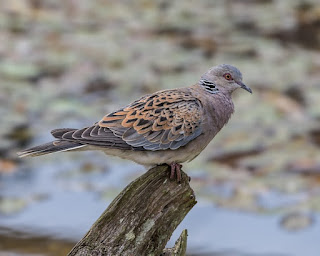Pigeons and doves are in the Columbidae family, and there really is no scientific difference between them. The way the names are used, such as calling the smaller bird a dove and the larger one a pigeon, seem to be tradition or preference. My wife and I see and hear mourning doves, and it is easy to tell that they are kinfolk to pigeons.
Many people consider pigeons nuisance birds, especially in big cities. Putting aside the annoyance, we can appreciate their patterns and markings. (We detest grackles, but I admit that their iridescence is impressive.) Consider the turtle dove.
 |
| Turtle Dove, Flickr / Andy Morffew (CC BY 2.0) |
The Bible refers to turtle doves, including the fact that they are migratory. They are also used symbolically. God has given us beauty in the world to appreciate, and we can admire birds. People should go outdoors if they are able, as birding is beneficial to mental health — and being outside is good for both physical health as well.
Turtle doves in the Bible are significant as a sacrifice, a symbol for Israel, and a bird in season. This paper sets out to help us appreciate the sight and sound of these birds in spring. Archaeology and ornithology unsurprisingly corroborate what we read in the Scriptures. First, we will consider some of the benefits of watching and listening to birds. Then we will reflect on the disturbing consistency of the persecution of this bird from the Talmud in AD 200 to the present day in Europe. Ultimately, the final reference in Luke’s Gospel causes us to consider Jesus.
Although it sounds technical in that abstract, it is not. To read the rest, click on "Turtle Dove: A Bird in Season."
